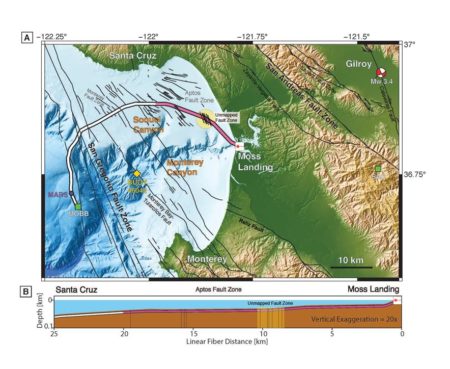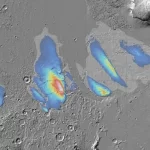November 29, 2019 – Off the Northern California coast between Santa Cruz and Monterey, researchers from UC Berkeley, Rice University, and the Monterey Bay Aquarium successfully demonstrated the temporary use of underwater telecommunications cables turning them into seismic sensors.
The cables are fibre optic and using pulses of laser light sent along the cable segments has created a new picture of the ocean floor in the Monterey Bay area. The cables in question are unlit, called Dark Fiber, so the experiment didn’t interrupt any telecommunications traffic. And what the laser pulses revealed in the four days of the experiment over the 50 kilometres (32 miles) segment travelled is a previously undiscovered system of faults and processes in the water column lying above never before observed. The cable acted like thousands of seismic sensors, each spaced a few meters apart along the seafloor. During the four days, the researchers recorded a 3.4 magnitude seaquake.
Using fibre-optic sensing technology this way is relatively new. The term the scientists use is DAS, which stands for Distributed Acoustic Sensing. Considering the effectiveness of the experiment and its results, it gives oceanographers, seismologists, and plate tectonics researchers a new tool that can take advantage of the overbuild of marine fibre-optic cable installed during the rapid expansion of the Internet and global telecommunications networks in the late 1990s. Apparently, there is a lot of dark fibre spanning the ocean floor, unused for phone and data traffic, but highly useful for studying the ocean floor.
What’s so interesting about the discovery of new faults is how it shows that previous efforts have been inadequate to chart these geological features associated with earthquakes along the Ring of Fire, where Earth’s tectonic plates crash into each other. The area of Monterey Bay has been studied by the U.S. Geological Survey for decades and still sending pulses of laser light down an unlit undersea cable revolutionized our view of the local seafloor.
The implications are significant for planning for seismic risks. A fault line along Japan’s coast in 2011 triggered the 9.1 magnitude earthquake and the accompanying tsunami that inundated the country’s coastline and led to the Fukushima nuclear plant meltdown. The event was unexpected because the fault was previously undetected.
Japan and California share a similar marine offshore environment with seismic activity from unknown and known faults likely to produce earthquakes that can be catastrophic. Dark fibre if used as seismometers could greatly enhance our understanding of seismic hazards and even detect ocean floor movements before an earthquake.
Nathaniel Lindsay, of the Earth and Planetary Science Department, UC Berkeley, in an article published yesterday by the American Association for the Advancement of Science (AAAS), describes the unique value of the density of seismic readings dark fibre cable can yield using DAS. He states, “There are many different opportunities using DAS, including offshore seismic hazard analysis, studying seafloor fault properties, recording small earthquakes offshore, offshore earthquake early warning, studying and monitoring coastal erosion, and understanding how ocean waves convert and dissipate energy at the coasts.”
Whether this Monterey Bay experiment leads to a rollout to other hazardous coastal regions will be left to academics and government policy makers. But it sure sounds like a worthwhile investment considering the $300 billion USD cost of the 2011 event and aftermath in Japan.















